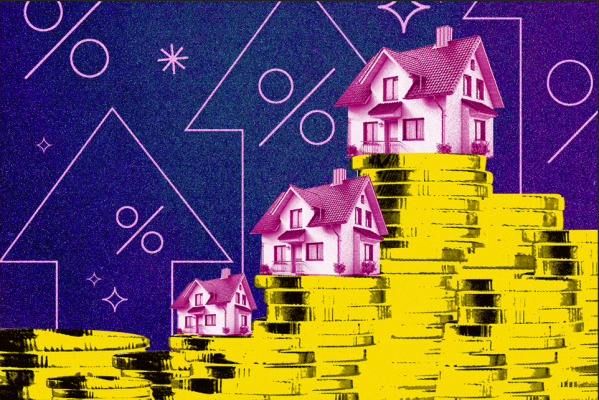The Fed Keeps Cutting Rates — So Why Aren't Mortgage Rates Going Down?

The Federal Reserve just announced another rate cut. But will it make a difference for antsy homebuyers waiting for mortgage rates to drop?
On Thursday, at the end of its November meeting, the Fed announced a reduction of 0.25 percentage points in the federal funds rate, or the rate at which banks lend each other money overnight. The move follows an initial cut of half a percentage point in September.
Both times, the consensus was that these interest rate cuts would — if indirectly — cause mortgage rates to move lower. After all, mortgage rates have steadily decreased in recent months: Between early July and mid-September, when the central bank announced the initial cut, they dropped by almost a full percentage point in anticipation of the move.
Since then, however, mortgage rates have been moving in the opposite direction. In the six weeks since the Fed announced the first cut, mortgage rates have increased by 0.70 percentage points — not the outcome many expected. In theory, this new cut should help rates move lower.
But if the first one didn’t work, will the second one do the trick?
Probably not — at least, not right away. Plus, the presidential election results may influence whether they come down at all.
The Fed’s impact on interest rates
The Federal Reserve's monetary policy influences individuals' and businesses' financial choices, from purchases made to hiring decisions. Generally, high interest rates make borrowing expensive and bring inflation down by reducing consumer demand; low interest rates do the opposite. But that influence can be direct or indirect.
The direct impact is on short-term rates, typically those charged on loans that come due in less than a year. Products with short-term rates include certificates of deposit (CDs) and adjustable-rate mortgages, the latter of which see interest rate adjustments every six months.
Long-term rates, however, are used on debt instruments that last from one year up to 30 years (or more), like mortgages. Because these rates stay constant for longer, they don’t react to changes in the federal funds rate as quickly.
Instead, they typically follow the movement of 10-year Treasury note yields — a debt obligation issued by the federal government to fund its expenses and debts — which mature after 10 years. Because most homeowners only hold mortgages for about a decade, mortgage rates are pegged to this note: When yields rise, so do rates. Treasury bonds, in turn, are influenced by economic conditions and investor behavior.
The reason rates moved lower before, not after, the September rate cut had more to do with investors' expectations about inflation and the strength of the U.S. economy than the central bank’s actions, says David Berson, chief U.S. economist at investment firm Cumberland Advisors.
In the months leading up to the rate cut, the economy was sending signals it was cooling down: Inflation was trending lower, job gains were slowing and unemployment was ticking higher. These signals, in turn, increased the odds that the Fed would cut rates to avoid a recession and achieve a gradual “soft landing.”
As the probability of an initial September cut — plus one or two more before year’s end — increased, mortgage lenders started to price the Fed’s move into their rate offerings, pushing mortgage rates lower before anything even happened.
In essence, lenders factored the cut in before the Fed took action based on their expectations about what the central bank would do.
After the rate cut, however, those same economic indicators started pointing toward a more resilient economy than anticipated. The September jobs report was hotter than forecast, and other financial data, such as retail sales, wage growth and unemployment, pointed toward economic growth, not a slowdown.
According to Berson, the strong economic data caused a shift in market expectations: Maybe inflation will tick higher, people theorized, or the Fed won’t cut rates as much as previously thought. The result is higher mortgage rates because “that’s what happens when it appears the economy is stronger than expected,” says Berson.
So while the Fed does influence interest rates, the effect of rate cuts on home loans, in particular, isn’t immediately felt. That’s not to say that mortgage rates won’t decrease if the central bank continues to lower the federal funds rate — they will, eventually. It’s just that in the meantime, the economy will truly determine the direction rates are heading.
How could a Trump presidency affect mortgage rates?
The federal deficit also influences Treasury yields because these bonds are used to pay the interest on the debt. The higher the debt, the more yields have to increase to attract investor interest.
According to the Committee for a Responsible Federal Budget, President-elect Donald Trump’s second term could add anywhere from $1.65 trillion to $15.55 trillion to the deficit over the next 10 years. And according to Lisa Sturtevant, chief economist at Bright MLS, this could lead to greater rate volatility over the coming months.
Since the election results were announced, yields on 10-year Treasuries jumped from 4.258% to almost 4.5%. They’re rising, said Sturtevant in emailed comments, “because investors expect Trump’s proposed fiscal policies to widen the federal deficit and reverse progress on inflation.”
If consumer prices rise significantly, it could mean the end of Fed rate cuts — or even a rate increase. Depending on whether these projections shake out, Treasury yields and the mortgage rates that follow them may end up heading higher than anyone expects.
More from Money:
The Fed Will Probably Cut Interest Rates Again This Week. But By How Much?
Donald Trump is the President-Elect, Here’s What It Means for Your Wallet

